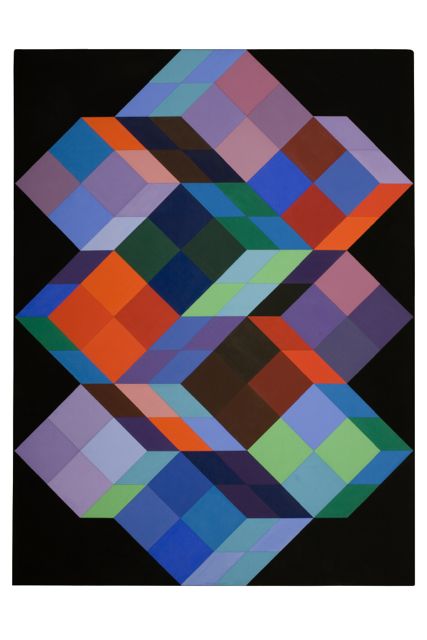
“Modernism in Changing Times: Works from 1968” at the Bechtler Museum
1968: a year of tumultuous change with the Prague Spring in the Czech Republic and Richard Nixon taking the presidency in the United States. It was a year of loss with the Tet Offensive launched in Vietnam and the assassinations of Robert Kennedy and Martin Luther King, Jr. It was also a year of firsts with the transplant of a sustainable heart and the orbit of the moon by a manned Apollo 8 spacecraft. This turbulent year, 1968, serves as the foundation for the Bechtler Museum of Modern Art’s new exhibition, “Modernism in Changing Times: Works from 1968,” which opened at the end of August and runs until January 24, 2014.
The exhibition shows the breadth of the contemporary art world in 1968 and surrounding years, as well as the Bechtler family’s diverse collecting interests. The 101 works on view range from Pop art with Warhol and Lichtenstein to Realism with Hockney and Chagall, and back again with some of the leading art movements of the 1960s, including Op art, Kinetic art and Concrete art. “We are once again dipping into the collection from a purely chronological perspective and have selected a point in time –1968 – that represents a period of exceptionally successful collecting on the part of the Bechtler family,” said John Boyer, president and CEO of the museum.
“Modernism in Changing Times” is very successful at displaying the diversity in styles and movements of the art of the 1960s in the United States and Europe. But in selecting such a pivotal year in history as the basis for the selected works, “Modernism in Changing Times” fails to develop the connection between the events of 1968 and the art created during this period. The introductory label sets up the tumultuous nature of 1968, reminding visitors of the tragic events, new inventions and icons of popular culture, and it proclaims the connection between political and social events with art:
“Through this tempestuous and at times terrifying year, the arts served as a podium and a refuge, as salve and scourge. Artistic diversions offered relief and distance during a time of distress but also engagement and public declaration during a time of transformation.” Yet when the viewer moves from introductory label to the heart of the exhibition –the art – it is difficult to understand and/or develop the connections without any didactic labels, explaining how the events of the 1960s impacted, inspired or engaged these artists, especially for the uneducated viewer or novice art lover. For instance, when viewing “Marilyn” by Andy Warhol, the impetus behind Pop art and Warhol’s interest in the numbing effect of repetitious images generated by mass media is largely lost. The art work becomes just another colorful portrait of the American pop culture icon, Marilyn Monroe, and while this is perhaps Warhol’s point, the Bechtler could let the viewer in on the paradox.
Victor Vasarely’s “Tridem K” is another missed opportunity. With its geometric colored cubes and 3-D quality, this example of Op art tested the assumptions and rules of fine art, playing with optical illusion to capture movement and a sense of 3-D space in a 2-D medium. Op artists and many other modern artists pushed the boundaries of fine art by redefining the acceptable materials, subjects and dimensional qualities of fine art. This spirit of experimentation was emblematic of the widespread counter cultural sentiment that characterized the 1960s, but unless the viewer comes in with a pre-existing knowledge of Op art or modern art, he or she is unlikely to create the connection between the art and the history.
Victor Vasarely, “Tridem K,” 1968, acrylic on canvas. © 2013 Artists Rights Society (ARS), New York / ADAGP, Paris.
Fortunately, the Bechtler Museum of Modern Art recently started a gallery attendant program where knowledgeable people are stationed in the galleries to provide information on the art, the Bechtler, and museum events. Gallery attendants are approachable with “Ask Me” buttons identifying them. They also carry tablets with them to research and find answers to difficult questions. This is a great resource for museum visitors who may be more likely to engage in a conversation about art than read a label. There are also several programming events around “Modernism in Changing Times” meant to deepen understanding of the art in the exhibition. One such program is a screening series of films from 1968. The next screening is October 20th at 7 p.m. with the film “Bullitt,” starring Steve McQueen.
The Bechtler Museum of Modern Art is an art museum not a history museum, so its focus on aesthetic appreciation with minimal educational labels is not surprising. But perhaps the aesthetic appreciation could be significantly deepened with a greater exploration of the connection between the art and the history.
Bechtler Museum of Modern Art: 420 South Tryon St., Charlotte; www.bechtler.org. Hours: Mon., 10-5 p.m.; Tues., closed; Wed.-Sat., 10-5 p.m.; Sun., 12-5 p.m.
Recent Content
-
Artsarticle ·
-
Artsarticle ·
-
Artsarticle ·


